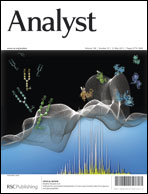In this work, a novel microwave-assisted method was developed for fast and batch fabrication of monolithic molecularly imprinted polymer (MIP) fibers. It was based on in situ polymerization in a flexible capillary mold under microwave irradiation. The proposed method greatly shortened the preparation time (about 20-fold) in comparison with the conventional heating. The model template, bisphenol A (BPA) imprinted MIP fiber, was prepared and used for solid phase microextraction (SPME) prior to high performance liquid chromatography (HPLC) determination of BPA and its analogues, i.e., diethylstilbestrol (DES) and hexestrol (HEX). Under the established optimum conditions, the limits of detection for BPA, DES and HEX were 2.0 ng mL−1, 5.1 ng mL−1, and 3.3 ng mL−1, respectively. The fiber-to-fiber extraction (n = 5) was reproducible with the relative standard deviation in the range of 6.6–9.5%. The MIP fiber was used for selective extraction of BPA, DES and HEX in tap water, sewage and urine samples, and the relative recoveries for MIP-SPME-HPLC analysis of BPA, DES and HEX ranged from 82.5% to 103.8%. The advantages provided by this microwave-assisted method will make it a useful tool for preparation of MIP fibers with good SPME performance.

You have access to this article
 Please wait while we load your content...
Something went wrong. Try again?
Please wait while we load your content...
Something went wrong. Try again?


 Please wait while we load your content...
Please wait while we load your content...